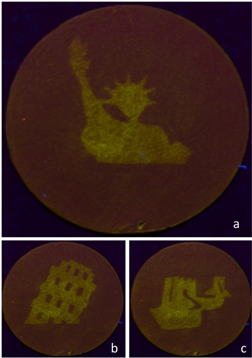October 10, 2018 – Light-activated switches are too small to be seen by the naked eye, but the molecular systems are hard at work in research related to drug design, adaptive materials and data storage. To unlock the promise of new generations of medical therapies and memory systems, researchers must first overcome the drawbacks of the microscopic devices that can be difficult to produce and lack versatility.
Doing some light work around the lab: A laser turns “on” and “off” molecular switches. While spelling “Dartmouth” in a toluene solution using light might be a neat trick, the switches can be used for serious work as well. In the future, switches like these might be used to develop highly-targeted drug therapies and high-density storage systems with the volume of a speck of dust. |
Image  |
| Filter papers covered with photo masks irradiated with a blue laser pointer demonstrate activation of hydrazone switches in solid state. Monitoring under 365 nm light revealed the images of (a) the Statue of Liberty, (b) the Pisa Tower, and (c) the Great Wall of China. Photos courtesy of Aprahamian Research Group/Dartmouth College. |
Researchers at Dartmouth College have developed a new molecular switch based on the hydrazone functional group that combines the most important properties of the current class of light-activated switches and solves many of the problems associated with them. The newly-developed molecule is easy to make, simple to work with, shows “on-off” fluorescence emission toggling, and can be used to write, read and erase information in both the liquid and solid state.
Looking into the future, switches like these may potentially be used for the development of sophisticated photomedications that deliver drugs with cellular-level precision. In years to come, hydrazone switches might also lead to the development of high-density memory devices with the volume of a speck of a dust.
As detailed in the Journal of the American Chemical Society, Dartmouth’s hydrazone system, “packs most, if not all, the desired, targeted and sought-after traits from photochromic compounds.”
“This is a switch that can do it all,” said Ivan Aprahamian, an associate professor of chemistry and head of the research team at Dartmouth. “What we developed is a new tool that combines all the good properties of known switches without their side effects, and in a simple, straight-forward design.”
Similar to flipping a physical switch, photochromic switches rely on lights of different wavelengths to move molecules between the “on” and “off” positions. The fluorescent feedback produced during the switching process can be used to store and read huge amounts of data at microscopic scale and even provide signals about where a medication is being delivered after the drug enters into a patient’s body, an important tool for drug targeting.
To toggle the switch in the Dartmouth study, researchers used a “blue light” operating at the same 450 nm wavelength of a laser pointer to write the information by activating the switch. A second 365 nm ultraviolet wavelength was used to erase the information by turning the switch off.
In the paper, the researchers demonstrated that the switch works in both water and fetal bovine serum buffer—a frequently used bio-medium—confirming that the molecular system can be useful as a drug delivery tool.
In addition to performing well in solution, the researchers found that the hydrazone switch also works on solid-state films. Molecules that go through large structural changes usually do not operate in solid state without complex manipulation. This added functionality allows it to be used effectively for data storage.
“Such an on-off fluorescence response in both solution and solid state for photochromic compounds is highly unusual,” said Baihao Shao, a PhD student at Dartmouth and the first author of the study.
The team was able to use both single-photon and two-photon light sources to operate the new switch. The near infrared, two-photon system allows the light to penetrate tissue deeper and makes it safer for use with humans. Two-photon activation also allows for 3D microscopy techniques that are important for advanced data storage.
The research paper notes that the hydrazone switch has a half-life of 75 years in solution at room temperature. In solid state, the switch’s memory could be indefinite. Such stability is another key feature that adds to its overall functionality for long-term data storage.
“We are extremely excited by the results as well as the reception it is getting from the scientific community. Based on these and yet unpublished results, we feel that this technology has the promise to be truly transformative,” said Aprahamian.
During the experiment, some erasure did occur during reading as the excitation light also results in slow switching, creating a challenge that the researchers are working to minimize.
Massimo Baroncini, Hai Qian, Laura Bussotti, Mariangela Di Donato and Alberto Credi also contributed to this research. The research was done in collaboration with the University of Bologna.

